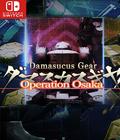Set in the distant future, Damascus Gear: Operation Osaka features a world that's been ravaged by a war against rogue AI mecha. Players are thrust into the role of their own character, a child born to two mercenaries who had recently passed away. The protagonist's sole inheritance is a GEAR, a powerful giant robot, and the maintenance crew to go with it. Unfortunately, it also comes with a massive debt that's too high to pay off even by selling the robot. As a result, you're forced to become a mercenary who ventures into the shifting labyrinth beneath the city in the hopes of finding enough materials to get out of debt. Meanwhile, a mysterious girl in your dreams warns you that something more dangerous is coming.
The plot is pretty forgettable, since the bulk of it involves ridiculous characters who want to fight you, or your AI sidekick being quirky and weird. It's not bad, but it's longwinded and goes on far too long when you'd rather get back to blasting things with your mecha.
The core ofthegameplay is a by-the-book dungeon-crawler. You enter a randomly generated dungeon and explore, open chests, and battle monsters. In this case, "monsters" are rogue mecha that you blast to pieces and then scavenge for parts to upgrade your own robot. You can either go into the dungeon on your own or complete missions, which enhance the rewards you receive for finishing a dungeon. It's a pretty simple cycle of go into the dungeon, get some loot, and go into a tougher dungeon.
The combat is fun and swift. You can dash and move with little effort and no cooldown, which gives the game a fast pace for a dungeon-crawler. You can equip multiple weapons, including rifles, shotguns, shoulder-mounted laser beams, and giant swords. There's no limit on how much you can use your weapons, and they have very generous cooldown times. Each weapon has strengths and weaknesses, so rifles are powerful but require you to be stationary, and machine guns let you move and shoot but aren't very strong.
Once you collect enough parts and level up enough, you can go to the local arena to take on what amounts to the boss characters. These were my least favorite parts of the game, as they're mostly hard stat checks. If you're willing to slowly plink down enemies, you can take them on "early," but by and large, you're going to fight what's essentially a regular foe with absurdly strong stats.
That's probably Operation Osaka's biggest issue: It's very stat-based, even for a dungeon-crawler. Some battles didn't feel winnable because I didn't have the patience to slowly plink down enemy HP with inferior weapons. You're supposed to tailor your mech to the enemy's weaknesses (e.g., lasers against phys-heavy foes or traps and ranged weapons against melee fighters), and that helps a lot, but at the end of the day, tedium isn't a fun way to discover that you need to grind more. This mostly comes up in the arena fights, and you quickly get a feel for how much effort you need to put in.
The basic flow of Operation Osaka is: Go into a dungeon, get equipment, use the equipment to power up, fight an arena battle, and repeat. There's time limit baked into the plot, but for certain reasons, it isn't as big of a deal as you'd think. This makes it a good game for a portable system because it's designed to be played in quick 5- to 10-minute chunks. While you can play the game docked, it originally came out for the PlayStation Vita, and it shows in its portability.
If what I've described sounds pretty simple, that's because it is. Operation Osaka is fairly bare-bones and by the numbers, with minimal surprises or much in the way of distinctive features. It's a loot-collecting dungeon-crawler, and its primary selling point begins and ends with "has giant robots." This isn't a bad thing, but it makes it difficult to recommend for anyone for whom giant robots isn't a selling point.
That is probably the thing that will most make or break Operation Osaka for you. The game is competent, it's fun to play, and the loot collection aspect is somewhat addictive. It doesn't really have anything else to recommend it. Even as a gigantic fan of mecha games myself, I struggled to remember anything distinctive about the characters, designs, gameplay, or plot. For people who aren't big mecha geeks, it'd make more sense to go for another loot-collecting game. Operation Osaka is for mech fans only.
It doesn't help that it's not a particularly great-looking game. Its background as a Vita title shows, and while there are some nice special effects for the various attacks, the game visuals are rather bland. The units are so small that the difference between various parts doesn't stand out particularly well, and the environments are repetitive. To the game's credit, it manages to keep everything clear and easy to read, even with a dozen robots spewing lasers on-screen, which keeps the gameplay fun. The voice acting revolves about 90% around your android sidekick character and gets repetitive enough to wish for an off switch.
At the end of the day, Damascus Gear: Operation Osaka never extends beyond the realm of a fun time-waster. It's not bad if you're looking for a cheap, mech-focused, loot-heavy dungeon-crawler. If you love giant robots, then Operation Osaka is a fun way to spend $20. Beyond that, it's just another dungeon-crawler on a system that is awash with them.
Score: 7.0/10
More articles about Damascus Gear: Operation Osaka











 The latest entry in the mech combat action RPG series, Operation Osaka offers up more action, more customization, and more options to players than ever before.
The latest entry in the mech combat action RPG series, Operation Osaka offers up more action, more customization, and more options to players than ever before.